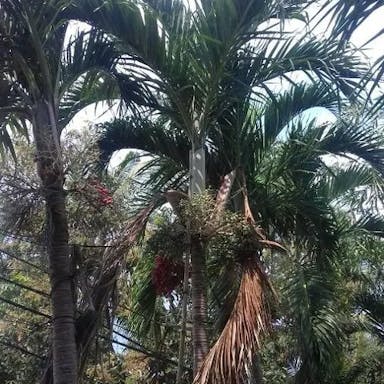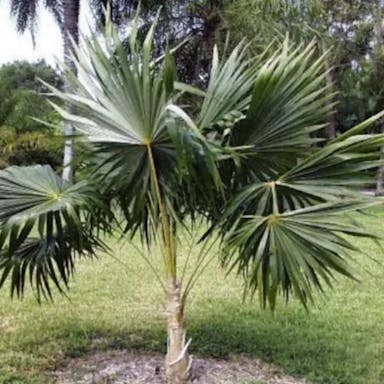Elephant palm, scientifically known as Kerriodoxa elegans, is a stunning palm species native to the rainforests of Southeast Asia. The graceful leaves are large, pinnate, and elegantly arching, Adding a tropical touch to any surrounding. The flowers are small and white, clustered on long inflorescences. The fruit produced is round and red when ripe, inviting birds and wildlife. This plant is regarded as a symbol of elegance and beauty in landscaping due to its form. Kerriodoxa elegans typically develops up to 20-30 feet in height, making it suitable for both interior and outdoor growth. This palm is moderately straightforward to increase, necessitating well-draining earth, regular irrigating, and partial shade to prosper. Its exotic appearance and low care make it a admired choice for botanical gardens and tropical-themed areas.
Elephant palm
- Scientific name
- Kerriodoxa elegans
Basic Information
- Arecaceae Family Kerriodoxa Genus Elephant palm Species
- Arecaceae > Kerriodoxa > Kerriodoxa elegans
- 83%
- The Completeness of This Encyclopedia
Please help us complete the encyclopedia, Terrarium is a encyclopedia service to be completed with everyone in the world. Currently, this page is 83% complete. For more information on how to contribute, please click here.
- Palmae
- Height
- 600cm ~
- Flower Color
- Leaf Color
- Anthesis
- spring
- Sunlight Exposure
Full Sun Long hours of sunlight from morning to afternoon Partial Shade A location in the shade of a tree or where either the morning or afternoon is shaded Full Shade A place where there is no direct sunlight
- Partial Shade
- Hardiness Zones
This is an indicator to know to which zone each plant can winter. Knowing the zone of each plant gives you an idea of the cold temperature resistance when grown in the ground without a roof. 2: -42.7 to -40.0 3: -39.9 to -34.4 4: -34.3 to -28.9 5: -28.8 to -23.3 6: -23.2 to -17.8 7: -17.7 to -12.2 8: -12.1 to -6.7 9: -6.6 to -1.1 10: -1.0 to 4.4 11: 4.5 to 10.0
- 11
- Cold resistance
- Poor
- Heat resistance
- Good
- Habitat of origin
- Thailand
- Growth Rate
- Slow
What is Elephant palm (Kerriodoxa elegans)?
What is Elephant palm (Kerriodoxa elegans)
Flower meaning
Paragraph 1:The Elephant palm plant's flower language commonly used in America reflects: - Strength - Resilience - Longevity These attributes reflect the plant's ability to withstand challenges and thrive in many conditions. Paragraph 2: Birth flowers are associated with month and date.
Calendar of Elephant palm (Kerriodoxa elegans)
Calendar
Elephant palm flowers typically bloom in the late spring to early summer months in the United States. The flowers are at their best during the months of May and June. Blooming usually occurs once a year, lasting for several weeks. The period required for full blooming can vary but generally takes around 2 to 4 weeks. To extend the blooming period, ensure the plant receives adequate sunlight, water, and nutrients. Pruning dead flowers can also promote continuous blooming. Maintaining consistent care and providing optimal growing conditions can help prolong the flowering season of Elephant palm plants.
How to grow Elephant palm (Kerriodoxa elegans)
Watering
For the Elephant palm, watering frequency should be moderate, typically once every 7-10 days during the growing season. Ensure the soil is well-draining to prevent waterlogging, which can lead to root rot. During the dormant season, reduce watering to once every 2-3 weeks to mimic its natural habitat conditions. Check the soil moisture level by inserting a finger about 1-2 inches deep; water when the topsoil feels dry. Adjust watering based on environmental factors such as temperature and humidity to maintain optimal soil moisture levels.
Soil and Fertilizer
Elephant palm grows well when the soil drains properly and has a pH level ranging from 6.0 to 7.5. Use a balanced fertilizer that has a ratio of nitrogen, phosphorus, and potassium of 3-1-2 or 3-1-3. Feed the plant every 2 to 3 months during the growing season of spring to early fall. Apply a slow-release fertilizer and follow the instructions on the package, typically using 1/4 to 1/2 cup for every 2 feet of plant height. Be sure to water the plant thoroughly after adding fertilizer to prevent burning the roots. Avoid using too much fertilizer because it can create problems with nutrients and harm the plant. Always monitor the soil to ensure good drainage and aeration for the best growth.
Sunlight and Place
The Elephant palm thrives in bright, indirect sunlight but can tolerate some direct sunlight. Intermittent sun exposure would keep this plant happy and prevent leaf scorching. It prefers temperatures above 50°F (10°C), with some cold endurance. Filtered light in summer helps avoid leaf burn from intense heat. Bright, indirect light in winter maintains vigor. Though it survives high heat, partial shade at peak times is beneficial. 65-85°F (18-29°C) is optimal. Around 4-6 hours of sun daily fulfills its light needs.
Advanced Information of Elephant palm (Kerriodoxa elegans)
Pruning
Elephant palm requires pruning to remove dead or damaged fronds and promote healthy growth. Pruning should be done in late winter or early spring to avoid stressing the plant during its growing season. To prune, use sharp, clean shears to cut fronds close to the trunk without damaging it. After pruning, apply a balanced fertilizer to encourage new growth and water the plant adequately.
Planting and Harvest
Elephant palm is best suited for potted planting due to its sensitivity to cold temperatures. When potting, choose a container with drainage holes to prevent waterlogging. Use well-draining soil and place the plant in a location with bright, indirect sunlight. Repotting should be done every 2-3 years or when the roots outgrow the pot. Carefully remove the plant from its current pot, gently loosen the roots, and place it in a slightly larger container. Water thoroughly after repotting to help the plant establish in its new home.
Propagation
Elephant palm can be propagated through seeds, division, or offsets. Seeds should be sown in well-draining soil, kept moist, and placed in a warm, bright location. Division involves separating the plant into smaller sections with roots attached. Cuttings can be taken from the stem and rooted in water or soil. Leaf cuttings can also be used by taking a healthy leaf and placing it in soil to root. To ensure successful propagation, it is recommended to use a combination of methods to increase the chances of success.
Pests and Diseases
Elephant palm is susceptible to common pests such as spider mites, mealybugs, and scale insects. These pests can cause damage by sucking sap from the plant, leading to yellowing of leaves and stunted growth. To prevent infestations, regularly inspect the plant for any signs of pests, and if detected, treat them with insecticidal soap or neem oil. Additionally, maintaining proper humidity levels can help deter these pests. Moreover, Elephant palm is prone to fungal diseases like root rot, leaf spot, and powdery mildew. These diseases often occur due to overwatering or poor air circulation. Symptoms include wilting, yellowing, or spotted leaves. To prevent fungal diseases, ensure proper drainage, avoid overwatering, and provide adequate air circulation around the plant. Fungicides can be used as a last resort if the infection is severe.
Habitat of Elephant palm (Kerriodoxa elegans)
Habitat
Toxicity of Elephant palm (Kerriodoxa elegans)
Health Benefits
- edible
- Inedible
- Toxic
- No toxicity
NO DATA
Toxic for dogs and cats
NO DATA
Q&A of Elephant palm (Kerriodoxa elegans)
- choice
Elephant palm seedlings ought to have a developed root structure and vigorous, verdant fronds. Seek out seeds that are chubby, stiff, and free from moldiness or impairment. When choosing seeds, opt for those which are fresh and feasible, since older seeds may have a lower rate of germination. There are two primary varieties of Elephant palm: the green variety, possessing bright green leaves, and the variegated variety, possessing leaves with white or yellow stripes. The green variety prevails more and is simpler to care for, while the variegated variety necessitates more attention to uphold its coloration. Verify that seedlings are free of pests or diseases, and choose those with compact increase and no indications of wilting.
- How Do You Take Care of an Elephant Palm?
To care for a Kerriodoxa elegans, known as Elephant Palm, make sure it has good drainage and gets indirect sun. Water thoroughly but let the soil dry out some between waterings. High humidity is beneficial. You could put it somewhere humid or use a humidifier. Feed with houseplant fertilizer when it's growing. Feed less in winter. Check regularly for problems. Treat right away to keep the palm healthy.












